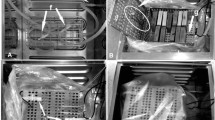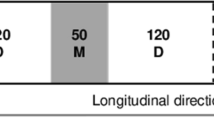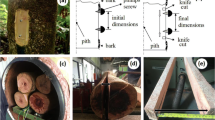Abstract
The temperatures of Hevea brasiliensis logs during the steaming process were determined and correlated with the cracks of the boards. Thermocouples were inserted at the center of the logs, and the temperatures were recorded inside the material during steaming at 54, 75 and 92 °C. Logs were cut and the cracks of the boards were measured. The results showed that: (1) the sigmoidal logistic model explains the variation of temperature in the logs; (2) the variation in the length of cracks between the peripheral boards and those taken near the pith were 194.6, 150.6 and 138.8 % for the material steamed at 54, 75 and 92 °C, respectively; and (3) the board’s cracks were smaller in the logs that reached the glass transition temperature. A chart to determine the steaming logs time as a function of the steam temperature and the desired temperature inside Hevea brasiliensis logs was developed.
Zusammenfassung
Die Temperatur beim Dämpfen von Hevea brasiliensis Stammabschnitten wurde bestimmt und mit den Rissen in den Brettern korreliert. Thermoelemente wurden bis zum Mark in die Stammabschnitte eingeführt und die Temperaturen während des Dämpfens bei 54, 75 und 92 °C wurden gemessen. Die Stammabschnitte wurden eingeschnitten und die Risse in den Brettern gemessen. Es ergaben sich folgende Ergebnisse. (1) Die Temperatur im Stammabschnitt veränderte sich nicht linear (Sigmoidfunktion). (2) Die Risslänge unterschied sich zwischen marknah eingeschnittenen Brettern und markfern eingeschnittenen Brettern um 194,6 % bei einer Dämpfung bei 54 °C, um 150,6 % bei 75 °C und um 138,8 % bei 92 °C. Die Risse in den Brettern waren kleiner bei den Stammabschnitten, die die Glasübergangstemperatur erreichten. Es wurde ein Diagramm zur Bestimmung der Dämpfungsdauer von Stammabschnitten in Abhängigkeit der Dämpfungstemperatur und der gewünschten Temperatur in den Hevea brasiliensis Stammabschnitten entwickelt.
Similar content being viewed by others
Avoid common mistakes on your manuscript.
1 Introduction
The growth stresses that occur in Hevea brasiliensis are responsible for many defects during all phases of processing the wood, resulting in yield loss of sawn wood (Lim and Sulaiman 1999; Lim et al. 2003; Watcharakuldilok and Vitayaudom 2008).
Techniques that have been used to relieve the tensions arising from growth stress include heating the logs in water or the application of saturated steam (Calonego and Severo 2005; Severo and Tomaselli 2000; Skolmen 1967; Calonego et al. 2010; Severo et al. 2010). The objective of these treatments is to soften the wood to relieve the growth stresses (USDA 1999).
Studies showed a reduction in growth stress of about 50 % in Eucalyptus saligna logs after 24 h of treatment in hot water (Skolmen 1967), significant reductions in the length and width of cracks (44 and 53 %, respectively) in Eucalyptus dunnii after 20 h of steaming (Severo and Tomaselli 2000); reduction in the length and width of cracks (about 34 and 48 %, respectively) in Eucalyptus grandis logs after 24 h of steaming at 90 °C (Calonego and Severo 2005); reductions of about 18.4, 27.7 and 43.4 % in Eucalyptus grandis logs with 30–35 cm, 25–30 cm and 20–25 cm in diameter, respectively, after 20 h of steaming at 90 °C (Calonego and Severo 2006). Log steaming under this condition homogenized the end-cracking index among boards taken from different diametrical positions from the pith outward to the bark of Eucalyptus grandis (Severo et al. 2010).
So far, there are no studies on the effect of steaming in Hevea brasiliensis logs. However, Srivaro et al. (2008) studied the effect of pre-steaming of lumber rubberwood and concluded that the thermal-treatment at 90 °C for 7 h caused a decrease of 11 % in the board’s end-cracks during the drying process.
Hence, there is a need for specific studies to determine the steaming time of logs and the temperature limits in wood (Severo and Tomaselli 2000; Calonego and Severo 2006).
Nevertheless, humidity migration and heat transfer are critical in many industrial processes of wood. Yet the transport of heat and humidity are very complex due to the heterogeneity and the porosity of the material (Calonego et al. 2010). During the steaming, the sapwood absorbs higher moisture content than the heartwood. The moisture content facilitates the flow of heat and, therefore, increases the temperature which softens the wood, thus demonstrating the differences in thermal properties between the two types of wood (Lenth and Haslett 2003).
Simultaneously, heating in saturated steam results in shorter treatment times than heating in dry environments. The temperature in the center of the boards of Pinus resinosa reached 56 °C after 23 min of steaming at 85 °C, and reached the same temperature after 47.8 min in an environment with 23.7 % relative humidity and 85 °C (Simpson and Illman 2004).
Increases in temperature and moisture content of the wood are useful in order to soften the physical structure of the material (Lenth and Kamket 2001; Romeiro de Aguiar and Perré 2005). When the wood reaches its glass transition temperature, its polymers are softened and thus, molecular rearrangement and microstructure of the material occurs and consequently the relief of internal stresses (USDA 1999; Lenth and Haslett 2003; Nakano 2005; Romeiro de Aguiar and Perré 2005; Calonego and Severo 2005; Calonego et al. 2010; Severo et al. 2010).
Furuta et al. (1997) showed that the glass transition temperature of hemicelluloses, lignin and cellulose are generally in the order of 40, 50 to 100 °C and above 100 °C, respectively. Hillis and Rozsa (1985) concluded that the hemicelluloses and lignin present glass transition temperature of 80 and 100 °C. Irvine (1984) showed that this property of lignin is between 60 and 90 °C and Kelley et al. (1987) reported that the glass transition of lignin occurs at temperatures between 60 and 70 °C.
However, the glass transition temperature of the wood is the same as that of the lignin, which is between 60 and 200 °C, and a decrease of the moisture content of the wood increases the glass transition temperature (Lenth and Kamket 2001). In general, for green wood lignin, the glass transition temperature is around 60 °C (Nakano 2006).
For Couratari guianensis wood with moisture content above fiber saturation point, the glass transition temperature is around 95 °C (Romeiro de Aguiar and Perré 2005). For Eucalyptus regnans, Eucalyptus marginata and Eucalyptus tetrodonta woods the glass transition temperature is between 62 and 87 °C, 68 and 90 °C and 66 and 90 °C, respectively (Irvine 1984).
Chan et al. (1989), in a study on Hevea brasiliensis wood, concluded that the glass transition temperature of lignin from dry wood and at 14.5 % moisture content were 128 and 77 °C, respectively. In the same conditions, the hemicelluloses present values of glass transition temperatures of 93 and 64 °C.
Thus, the aim of this study was to evaluate the temperature of the Hevea brasiliensis logs during steaming and its correlation with the end-cracks in the sawing process.
2 Materials and methods
2.1 Collection of material
This study utilized trees from 53-year-old Hevea brasiliensis ungrafted from the Miraculous Water Farm, located in Tabapuã, São Paulo, Brazil. After felling, the trees were sectioned into 3.0 m logs. Thirty-three logs with diameters of 34.6 ± 4.4 cm were used.
The treatments to relieve growth stress included making grooves in the logs. Two grooves were machined to a depth equal to one-third of the radius of each log at 10 cm from the crosscut section of the log, according to the methodology proposed by Sales (1986) and Kubler (1987).
A 3 cm disk was taken between each log to determine the moisture content based on the oven-dry mass of the material and its basic density. A balance with 0.1 g of accuracy and an oven at a temperature of 103 ± 2 °C were used.
2.2 Log steaming and temperature determination
The procedure used to relieve growth stress was steaming of the logs. The 3.0 m logs were steamed for 36 h at a temperature of 54 ± 4, 75 ± 4 and 92 ± 3 °C and 100 % relative humidity. The steamer was equipped with an electric boiler with a steam-producing capacity of 30 kgf h−1 and operating pressure of 8 kgf cm−2.
Thermocouples were installed in each log to assess the temperature during steaming according to the methodology developed by Calonego and Severo (2006) and Calonego et al. (2010). Figure 1a shows this scheme more clearly.
The temperature behavior of each log and of the internal environment of the chamber (steam) was monitored with thermocouples attached to a Campell Scientific Datalogger, during the steam treatment.
2.3 Crack analysis of the board
The steamed logs were cut into flat sawn boards in the Forestry Institute of São Paulo located in Mandurí, São Paulo, Brazil. The logs were cut using a twin band saw and subsequently sawn into boards of 28 mm thickness. This procedure was performed 10 days after the steaming treatment. The boards presented an initial moisture content of 72.6 %.
To evaluate growth stress in H. brasiliensis logs, it was determined how this stress had manifested in the lumber through the end-cracking of boards. The lengths of end-cracks was measured in the central and peripherals boards taken from the logs after the sawing process, as shown in Fig. 1B.
3 Results and discussion
The temperature behavior of each Hevea brasiliensis log, with 0.54 g cm−3 of specific gravity and 86.6 % moisture content, during steaming, was accurately ascertained.
At each minute of the 36 h of steaming, the temperature in the center of the logs and of the steam was measured according to the method presented in this study.
Due to the tendency of the data and according to recommendations by Calonego et al. (2010) the authors selected a nonlinear sigmoidal logistic regression model to represent the data pairs: y = A2 + (A1 + A2)/(1 + (x/x0)p), where: “A1”, “A2”, “x0”, “p” are the model constants; “x” the logs steaming time in hours; and “y” the temperature in the logs center in centigrade grade.
Figure 2 shows the adjusted models to estimate the temperature in the center of the Hevea brasiliensis logs for 36 h of steaming at 54 ± 4, 75 ± 4 and 92 ± 3 °C. In these cases, the coefficients of determination (R2) were, 0.98, 0.93 and 0.98, respectively, and it is shown that the selected model can be used to explain the pairs of data.
Logistic sigmoidal curve adjusted to the temperature behavior in the center of Hevea brasiliensis logs during steaming at various temperatures
Regressionskurve (Sigmoidfunktion), angepasst an den Temperaturverlauf im Markbereich von Hevea brasiliensis Stammabschnitten während des Dämpfens bei verschiedenen Temperaturen
Through the application of statistical models, it was found, that at the end of the steaming at 54 ± 4, 75 ± 4 and 92 ± 3 °C, the Hevea brasiliensis logs had an internal temperature of 45, 56 and 71 °C, respectively.
It can be seen that only Hevea brasiliensis steamed at the greater temperatures reaches the glass transition temperature of the wood. This temperature is approximately between 60 and 90 °C as recommended by Irvine (1984) and Kelley et al. (1987) for green wood in general, and is similar to that proposed by Chan et al. (1989) who concluded that Hevea brasiliensis wood presented glass transition temperature slightly below 77 °C when saturated with water.
Graphs to estimate the temperature at the center of the log at various times and temperatures of steaming are shown in Fig. 3 for Hevea brasiliensis with diameters of 34.6 ± 4.4 cm. As an illustration of how to use the graph, it is assumed that the target temperature of the log is 62 °C and the steam temperature of the equipment is 85 °C. This value gives a steaming time estimate of approx. 30 h (Fig. 3, dashed line).
Graph to estimate the temperature in the center of Hevea brasiliensis logs with diameters of 34.6 ± 4.4 cm at various times and temperatures of steaming
Diagramm zur Schätzung der Temperatur im Markbereich von Hevea brasiliensis Stammabschnitten mit einem Durchmesser von 34,6 ± 4,4 cm in Abhängigkeit der Dämpfungsdauer und –temperatur
Table 1 shows the average length of end-cracks in the boards of Hevea brasiliensis steamed under different temperature conditions.
It was found that the log steamed at 54 ± 4 °C produces boards with higher end-cracks. The logs steamed at greater temperatures presented a greater relief of growth stresses, shown by the smaller difference between the cracks’ length in the central and peripheral boards. This result was expected because the relief of internal stresses of wood is directly related to the softening of the material (USDA 1999; Lenth and Kamket 2001; Romeiro de Aguiar and Perré 2005; Calonego et al. 2010). This characteristic is related to the glass transition temperature of lignin as recorded by several authors among them Nakano (2005, 2006), Calonego et al. (2010), Severo et al. (2010).
Similar results were obtained by Calonego et al. (2010), who studied the effect of steaming on the board’s cracks of Eucalyptus grandis and concluded that the material that reached the glass transition temperature presented smaller end-cracks and greater homogeneity between the peripheral boards and those taken near the pith.
These results will allow the use of optimal steaming time and temperature to avoid wasting energy and improve the quality of Hevea brasiliensis wood during sawing.
4 Conclusion
This study shows the development of a chart to determine the steaming time as a function of steam temperature and desired temperature inside Hevea brasiliensis logs. It was found that the sigmoidal logistic model explains the temperature in the logs. The variation in the length of cracks between the peripheral boards and those taken near the pith were 194.6, 150.6 and 138.8 % for the rubberwood steamed at 54, 75 and 92 °C, respectively. Finally, the board’s cracks were smallest in the logs that reached the glass transition temperature.
References
Calonego FW, Severo ETD (2005) Effect of log steaming on the reduction of defects associated with growth stress of Eucalyptus grandis. Ciênc Florest 15(4):431–440 (in Portuguese)
Calonego FW, Severo ETD (2006) Steaming times estimates for Eucalyptus grandis logs. Rev Árvore 30(3):457–462 (in Portuguese)
Calonego FW, Severo ETD, Cunha AR, Gaia DC (2010) Use of glass transition temperature for stabilization of board’s cracks of Eucalyptus grandis. An Acad Bras Ciênc 82(3):791–797
Chan KY, Yap MGSL, Chia HL, Teoh SH (1989) Viscoelastic behaviour of rubberwood-polymer composites. Radiat Phys Chem 33(3):205–210
Furuta Y, Aizawa H, Yano H, Norimoto M (1997) Thermal-softening properties of water-swollen wood: IV. Effects of chemical constituents of the cell wall on the thermal-softening properties of wood. Mokuzai Gakkaishi 43(9):725–730
Hillis WE, Rozsa AN (1985) High temperature and chemical effects on wood stability: the effect of heat on the softening of radiate pine. Wood Sci Technol 19(1):57–66
Irvine G (1984) The glass transitions of lignin and hemicellulose and their measurement by differential thermal analysis. Tappi J 67(5):118–121
Kelley SS, Timothy GR, Glasser WG (1987) Relaxation behaviour of the amorphous components of wood. J Mater Sci 22(2):617–624
Kubler H (1987) Growth stresses in trees and related wood properties. For Prod Abstr 10(3):61–119
Lenth CA, Haslett AN (2003) Moisture uptake patterns in pressure steaming of Radiata Pine. Holz Roh-Werkst 61(6):444–448
Lenth CA, Kamket FA (2001) Moisture dependent softening behavior of wood. Wood Fiber Sci 33(3):492–507
Lim SC, Sulaiman A (1999) Structure and characteristics of rubberwood. For Res Inst Malays 3(39):17–26
Lim SC, Gan KS, Choo KT (2003) The characteristics, properties and uses of plantation timbers-rubberwood and Acacia mangium. Timber Technol Bull 26:1–11
Nakano T (2005) Effects of quenching on relaxation of wet wood. J Wood Sci 51(2):112–117
Nakano T (2006) Analysis of the temperature dependence of water sorption for wood on the basis of dual mode theory. J Wood Sci 52(6):490–495
Romeiro de Aguiar OJ, Perré P (2005) Wood accelerating drying process based on its rheological properties. United States Patent, US no: 006910284B2
Sales CG (1986) Growth stresses: main results obtained on the study of guyana species and consequences for and use. In: IUFRO World Congress, 18, Ljubljana. Proceedings of IUFRO, Ljubljana, 1986, vol 5, pp 234–248
Severo ETD, Tomaselli I (2000) Vaporization on the reliase of growth stresses in logs of Eucalyptus dunnii from two origin. Sci Agrar 1(1–2):29–32 (in Portuguese)
Severo ETD, Calonego FW, Matos CAO (2010) Lumber quality of Eucalyptus grandis as a function of diametrical position and log steaming. Bioresour Technol 101(7):2545–2548
Simpson WT, Illman BL (2004) Heat sterification times of red pine boards. For Prod J 54(12):240–244
Skolmen RG (1967) Heating logs to relieve growth stresses. For Prod J 17:41–42
Srivaro S, Wongprot T, Matan N, Kyokong B (2008) Accelerated conventional temperature drying of 30 mm thick rubberwood lumber. Songklanakarin J Sci Technol 30(4):475–483
USDA (1999) Wood handbook: wood as an engineering material. FPL, Washington
Watcharakuldilok S, Vitayaudom S (2008) The utilization of rubber wood in Thailand. In: International rubberwood workshop, processing technology in the Asia-Pacific region, Haikou. Proceedings of ITTO/CFC, Haikou, 2008, pp 99–106
Acknowledgments
The authors thank the National Council for Scientific and Technological Development (CNPq), Brazil for financial support through grant numbers 147537/2010-0.
Author information
Authors and Affiliations
Corresponding author
Rights and permissions
About this article
Cite this article
Pelozzi, M.M.A., Severo, E.T.D., Rodrigues, P.L.M. et al. Temperature charts of Hevea brasiliensis during log steaming and its effect on the board cracks. Eur. J. Wood Prod. 72, 123–128 (2014). https://doi.org/10.1007/s00107-013-0759-3
Received:
Published:
Issue Date:
DOI: https://doi.org/10.1007/s00107-013-0759-3







